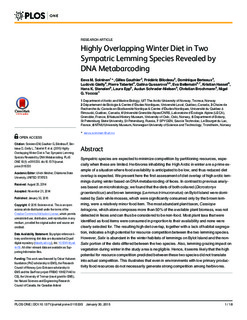| dc.contributor.author | Soininen, Eeva M | |
| dc.contributor.author | Gauthier, Gilles | |
| dc.contributor.author | Bilodeau, Frederic | |
| dc.contributor.author | Berteaux, Dominique | |
| dc.contributor.author | Gielly, Ludovic | |
| dc.contributor.author | Taberlet, Pierre | |
| dc.contributor.author | Gussarova, Galina | |
| dc.contributor.author | Bellemain, Eva | |
| dc.contributor.author | Hassel, Kristian | |
| dc.contributor.author | Stenøien, Hans K. | |
| dc.contributor.author | Epp, Laura | |
| dc.contributor.author | Schrøder-Nielsen, Audun | |
| dc.contributor.author | Brochmann, Christian | |
| dc.contributor.author | Yoccoz, Nigel Gilles | |
| dc.date.accessioned | 2015-11-24T13:17:55Z | |
| dc.date.accessioned | 2015-12-09T09:41:03Z | |
| dc.date.available | 2015-11-24T13:17:55Z | |
| dc.date.available | 2015-12-09T09:41:03Z | |
| dc.date.issued | 2015 | |
| dc.identifier.citation | PLoS ONE 2015, 10(1) | nb_NO |
| dc.identifier.issn | 1932-6203 | |
| dc.identifier.uri | http://hdl.handle.net/11250/2367327 | |
| dc.description.abstract | Sympatric species are expected to minimize competition by partitioning resources, especially when these are limited. Herbivores inhabiting the High Arctic in winter are a prime example of a situation where food availability is anticipated to be low, and thus reduced diet overlap is expected. We present here the first assessment of diet overlap of high arctic lemmings during winter based on DNA metabarcoding of feces. In contrast to previous analyses based on microhistology, we found that the diets of both collared (Dicrostonyx groenlandicus) and brown lemmings (Lemmus trimucronatus) on Bylot Island were dominated by Salix while mosses, which were significantly consumed only by the brown lemming, were a relatively minor food item. The most abundant plant taxon, Cassiope tetragona, which alone composes more than 50% of the available plant biomass, was not detected in feces and can thus be considered to be non-food. Most plant taxa that were identified as food items were consumed in proportion to their availability and none were clearly selected for. The resulting high diet overlap, together with a lack of habitat segregation, indicates a high potential for resource competition between the two lemming species. However, Salix is abundant in the winter habitats of lemmings on Bylot Island and the non-Salix portion of the diets differed between the two species. Also, lemming grazing impact on vegetation during winter in the study area is negligible. Hence, it seems likely that the high potential for resource competition predicted between these two species did not translate into actual competition. This illustrates that even in environments with low primary productivity food resources do not necessarily generate strong competition among herbivores. | nb_NO |
| dc.language.iso | eng | nb_NO |
| dc.publisher | Public Library of Science | nb_NO |
| dc.title | Highly overlapping winter diet in two sympatric lemming species revealed by DNA metabarcoding | nb_NO |
| dc.type | Journal article | nb_NO |
| dc.type | Peer reviewed | en_GB |
| dc.date.updated | 2015-11-24T13:17:55Z | |
| dc.source.volume | 10 | nb_NO |
| dc.source.journal | PLoS ONE | nb_NO |
| dc.source.issue | 1 | nb_NO |
| dc.identifier.doi | 10.1371/journal.pone.0115335 | |
| dc.identifier.cristin | 1188193 | |
| dc.description.localcode | © 2015 Soininen et al. This is an open access article distributed under the terms of the Creative Commons Attribution License, which permits unrestricted use, distribution, and reproduction in any medium, provided the original author and source are credited. | nb_NO |
